Did Plymouth Put A 392 In Any Of Their Cars
 | |
| Type | Partition of Chrysler |
|---|---|
| Manufacture | Automotive |
| Founded | July vii, 1928 (1928-07-07) |
| Founder | Walter Chrysler |
| Defunct | June 29, 2001 (2001-06-29) |
| Fate | Discontinued |
| Successor | Chrysler Dodge |
| Headquarters | Auburn Hills, Michigan U.South. |
| Products | Cars, minivans, trucks |
| Owner | Chrysler Corporation (1928–1998) DaimlerChrysler (1998–2001) |
| Parent | Chrysler |
Plymouth was a brand of automobiles produced by Chrysler Corporation and its successor DaimlerChrysler. The brand was launched in 1928 to compete in what was then described as the "depression-priced" market segment that was dominated by Chevrolet and Ford. It became the high-volume seller for the automaker until the late 1990s. Plymouth cars were marketed primarily in the United states. The brand was withdrawn from the marketplace in 2001. The Plymouth models that were produced up to then were either discontinued or rebranded as Chrysler or Dodge.
History [edit]
Origins [edit]

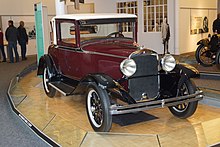
1928 Plymouth Model Q Roadster
The Plymouth automobile was introduced at Madison Square Garden on July vii, 1928.[ane] It was Chrysler Corporation's first entry in the low-priced field previously dominated by Chevrolet and Ford.[2] Plymouths were initially priced higher than the competition, just offered standard features such as internal expanding hydraulic brakes that Ford and Chevrolet did non provide.[3] Plymouths were originally sold exclusively through Chrysler dealerships,[3] offer a low-cost culling to the upscale Chrysler-brand cars, listing the iv-door 5-passenger Touring sedan at US$695 ($10,475 in 2020 dollars [4]).[v] The logo featured a rear view of the ship Mayflower which landed at Plymouth Rock in Plymouth, Massachusetts. However, the inspiration for the Plymouth brand name came from Plymouth binder twine, produced by the Plymouth Cordage Company, also of Plymouth. The name was chosen by Joe Frazer due to the popularity of the twine amongst farmers.[6]
The origins of Plymouth can be traced back to the Maxwell automobile. When Walter P. Chrysler took over control of the troubled Maxwell-Chalmers car company in the early on 1920s, he inherited the Maxwell as part of the parcel. Afterwards he used the company's facilities to aid create and launch the half-dozen-cylinder Chrysler auto in 1924, he decided to create a lower-priced companion motorcar, using lessons learned when he was running Buick under William Durant at GM. Then for 1926, the Maxwell was reworked and rebadged as the low-cease four-cylinder Chrysler "52" model. In 1928, the "52" was once again redesigned to create the Chrysler-Plymouth Model Q, although print advertisements called information technology "Plymouth" and didn't mention engine size or model designation.[7] The "Chrysler" portion of the nameplate was dropped with the introduction of the Plymouth Model U in 1929.

1938 Plymouth 4-door sedan
Smashing Low, 1930s–1940s [edit]

1939 Plymouth in a Swedish 1940s fashion photograph
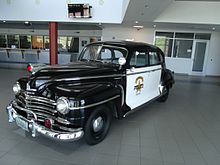
1947 Plymouth police automobile of Glendale Police Dept. Arizona

1949 Plymouth Special Palatial Iv Door Sedan
While the original purpose of the Plymouth was to serve the lower stop of a booming automobile market, during the Great Depression of the 1930s the sectionalisation helped significantly in ensuring the survival of the Chrysler Corporation when many other car companies failed. Beginning in 1930, Plymouths were sold by all 3 Chrysler divisions (Chrysler, DeSoto, and Dodge).[8] Plymouth sales were a bright spot during this dismal automotive period, and by 1931 Plymouth rose to number three in sales among all cars.[5] In 1931 with the Model PA, the company introduced floating power and boasted, "The smoothness of an 8 – the economy of a 4."[nine]
In 1933, Chrysler decided to catch up with Ford, Chevrolet and Pontiac in engine cylinder count. The 190 cu in (iii.one 50) version of Chrysler's flathead-vi engine was equipped with a downdraft carburetor and installed in the new 1933 Plymouth PC, introduced on November 17, 1932. Nonetheless, Chrysler had reduced the PC's wheelbase from 112 to 107 in (284.5 to 271.8 cm), and the car sold poorly. Past April 1933, the Dodge sectionalisation's Model DP chassis, with a 112-inch (284.five cm) wheelbase, was put under the PC body with DP front fenders, hood, and radiator trounce. The model designation was advanced to 'PD'. The PC was redesigned to wait similar to the PD and became the 'Standard Vi' (PCXX). It had been the 'Plymouth Half-dozen' at the introduction and was sold through to the end of 1933, but in much lower numbers. In 1937, Plymouth (along with the other Chrysler makes) added safety features such as flat dash boards with recessed controls and the back of the forepart seat padded for the rear seat occupants[10]
The PC was shipped overseas to Sweden, Denmark, and the United kingdom of great britain and northern ireland, besides as Australia. In the UK, it was sold every bit a 'Chrysler Kew', the boondocks of Kew being the location of the Chrysler manufactory in a district in the London Borough of Richmond upon Thames. The flathead six which started with the 1933 Model PC stayed in the Plymouth until the 1959 models.
In 1939, Plymouth produced 417,528 vehicles, of which 5,967 were two-door convertible coupes[11] with rumble seats. The 1939 convertible coupe was prominently featured at Chrysler'southward showroom at the 1939 New York World's Fair, advertised as the outset mass-production convertible with a power folding top. Information technology featured a 201 cu in (3.iii Fifty), 82 hp (61 kW; 83 PS) version of the flathead six engine.
For much of its life, Plymouth was 1 of the top-selling American car brands; information technology, together with Chevrolet and Ford, was commonly referred to as the "low-priced three" marques in the American market.[12] Plymouth almost surpassed Ford in 1940 and 1941 as the second-about pop make of automobiles in the U.South.
1950s [edit]


1956 Plymouth Fury, second year for Virgil Exner's "Forwards Look" cars
In 1957, Virgil Exner's new Forward Look design theme, advertised by Plymouth with the tagline "Suddenly, it's 1960",[thirteen] produced cars with avant-garde styling compared to Chevrolet or Ford. The 1957 total production soared to 726,009, about 200,000 more 1956, and the largest output yet for Plymouth. However, the 1957–1958 Forward Expect models suffered from poor materials, spotty build quality, and inadequate corrosion protection; they were rust-decumbent and greatly damaged Chrysler's reputation.[xiii] [xiv]
In 1954, Chrysler started its decade-long unsuccessful attempt to develop and market a viable auto powered by a turbine engine when it installed an experimental turbine developed specifically for road vehicles in a Plymouth.[xv] The car was a Belvedere two-door hardtop.
In 1956, Plymouth introduced the Fury, a "halo" model in the Belvedere serial that featured a high operation 240-hp 303 cubic inch V8, and gold-anodized trim on a body available in Eggshell White only and express to the 2-door hardtop. The Fury continued to be a special, loftier-end car until 1959, when it replaced the Belvedere as the de luxe series, available in hardtops, convertible and sedans. 1957 and '58 Furys were painted in Buckskin Beige, replacing Eggshell White as the only available exterior color. Optional equipment included air conditioning, automated manual, power steering and brakes. In 1959, a special Sport Fury was available as the "special" sporty Plymouth.
1960s [edit]


Although Plymouth sales suffered equally a effect of the quality control problems and excesses of the Exner-styled models in the early on 1960s, people bought enough of the cars to keep the division assisting. Starting in 1961, the Valiant compact became a Plymouth, further boosting sales. Under the impression that Chevrolet was almost to "downsize" its 1962 models, Chrysler introduced a significantly smaller standard Plymouth for 1962. Every bit is known, Chevrolet's large cars were not downsized, catching Plymouth in a sales slump in a market where "bigger was better". The 1963 Fury, Belvedere, and Savoy were slightly larger, featuring a totally new body style, highlighted by prominent outboard front end parking lights. For 1964, Plymouth got another major restyle, featuring a new "slantback" roofline for hardtop coupes that would evidence popular.

1968 Plymouth Roadrunner, one of the Muscle automobile era models
For 1965, the Plymouth Fury models were built on the new C-torso platform. The Savoy line was discontinued and the Belvedere was classified as an intermediate, retaining the B-body platform used starting 1962. The depression-end series was Fury I, the mid-level model was Fury II, and the higher-end models were Fury IIIs. The Sport Fury, which featured bucket seats and a panel shifter, was a mix of luxury and sport. Ford and Chevrolet had introduced luxury editions of their big cars for 1965 and Plymouth responded with the 1966 Sport Fury with a 383 CID and the VIP was introduced every bit a more luxurious version of the Fury. Furys, Belvederes, and Valiants continued to sell well during the late-1960s and early on-1970s. While Fury I and Fury II were merely available in the U.South. as sedans, Fury II was available as a two-door hardtop in addition to the pillared sedans in Canada.
The functioning machine marketplace segment expanded during the tardily 1960s and early on 1970s. The 1964 Barracuda fastback is considered the first of Plymouth'south sporty cars. Based on the Valiant, it was available with the Slant Six, or 273 cu in (four.5 L) small block V8. For 1967, Plymouth introduced the Belvedere GTX, a bucket-seat high-style hardtop coupe and convertible that could be ordered with either the "Super Commando" 440 cu in (seven.two L) or Hemi 426 cu in (7.0 50) V8 engines. Looking for an advantage at the drag races, 1968 had a stripped-down Dais coupe, the Road Runner, which featured a bench seat and minimal interior and exterior trim, merely was available with Chrysler's big-block engines and a floor-mounted four-speed manual transmission. The Barracuda, originally a "compact sporty car", became available with the 426 Hemi and 440 big-block engines in 1968. The GTX, Barracuda, Route Runner, Sport Fury GT, and Valiant Duster 340, were marketed by Plymouth every bit the 'Rapid Transit System', which was like to Dodge's 'Scat Pack' concept. During this time, the brand as well competed in professional automobile racing. Examples include Richard Piffling's career with Plymouth in NASCAR; Dan Gurney, who raced a 'Cuda as role of the All American Racers in numerous Trans Am events; and Sox and Martin, 1 of the virtually well-known drag-racing teams of the period, simply raced Plymouths after 1964.
1970s [edit]

1973 Plymouth 'Cuda coupe

Pete Hamilton with Niggling Enterprises 1970 Plymouth Superbird

Gran Fury Sport Suburban 1977
By the 1970s, emissions and safety regulations, along with soaring gasoline prices and an economic downturn, meant demand dropped for all musculus-type models. As with other American vehicles of the time,[ citation needed ] there was a progressive decrease in the Barracuda'south functioning. To meet increasingly stringent safety and frazzle emission regulations, big-block engine options were discontinued. The remaining engines were detuned year past yr to reduce exhaust emissions, which also reduced their power output. There was also an increase in weight as bumpers became larger and, starting in 1970, Due east-trunk doors were equipped with heavy steel side-impact protection beams. Higher fuel prices and performance-auto insurance surcharges deterred many buyers as the interest in high-performance cars waned. Sales of pony cars were on the decline.[16] Sales had dropped dramatically after 1970, and while 1973 showed a sales uptick, Barracuda product concluded one April 1974, ten years to the day after it had begun. The redesign for the 1970 Barracuda removed all its previous commonality with the Valiant. The original fastback blueprint was deleted from the line and the Barracuda now consisted of coupe and convertible models. The all-new model, styled by John E. Herlitz, was built on a shorter, wider version of Chrysler's existing B platform, chosen the E-body.[17] Sharing this platform was the newly launched Contrivance Challenger; however no exterior sheet metal interchanged betwixt the ii cars, and the Challenger, at 110 inches (2,794 mm), had a wheelbase that was 2 inches (51 mm) longer than the Barracuda.
The E-body Barracuda was now "able to shake the stigma of 'economic system car'."[xviii] Three versions were offered for 1970 and 1971: the base Barracuda (BH), the luxury oriented Gran Coupe (BP), and the sport model 'Cuda (BS).[xix] Outset mid-yr 1970, and catastrophe with the 1971 model, in that location also was the Barracuda Coupe (A93), a low-finish model that included the 198 cu in (3.2 Fifty) Camber Six as a base engine, lower-grade interior, and (like other Coupe serial Chrysler Corp. offered that twelvemonth) had fixed quarter glass instead of coil-down rear passenger windows.[twenty] The high-performance models were marketed as 'Cuda deriving from the 1969 choice. The Eastward-body's engine bay was larger than that of the previous A-body, facilitating the release of Chrysler'south 426 cu in (7.0 Fifty) Hemi for the regular retail market.[ citation needed ]
For 1970 and 1971, the Barracuda and Barracuda Gran Coupe had 2 six-cylinder engines bachelor — a new 198 cu in (3.2 L) version of the slant-6, and the 225 — as well as three different V8s: a 318 cu in (5.2 Fifty), too every bit a 383 cu in (six.iii L) with two-barrel carburetor and single exhaust and with four-barrel carburetor and dual exhaust producing 330 hp (246 kW) SAE gross. The Cuda had the 383ci 335 hp (250 kW) SAE gross (same as Contrivance's 383 Magnum) as the standard engine. Optional were the 440 cu in (seven.two 50) with 4-butt carburetor "Super Commando" or the six-butt "Super Commando Six Pak" also as the426 cu in (7.0 L) Hemi.[21] The 440- and Hemi-equipped cars received upgraded pause components and structural reinforcements to help transfer the power to the road.[ commendation needed ]
In 1970 the power plant options offered to the customer were:
- 275 hp (200 kW) SAE gross in the 340-4V.
- 335 hp (250 kW) SAE gross in the high performance 383-4V,
- 375 hp (280 kW) SAE gross in the 440-4V,
- 390 hp (290 kW) SAE gross in the 440-6V, and
- 425 hp (317 kW) SAE gross in the 426-8V.
Other Barracuda options included decal sets, hood modifications, and unusual "loftier bear on" colors.
The compact Valiant sold well and built a reputation for attractive styling, durability, economic system, and value. Although the Valiant hardtop was discontinued for 1967, it was reintroduced as a virtual clone of the Dodge Dart Swinger for 1971 under the model proper noun "Valiant Scamp". The Scamp was produced along with the Valiant, Dodge Sprint, and Swinger until 1976, when it was replaced with the Volaré. Featuring transverse-mounted torsion bars and a slightly larger body, the Volaré (and its Dodge twin, the Aspen) was an instant sales success. Available every bit coupe, sedan, or station railroad vehicle, the Volaré offered a smoother ride and better treatment than the Sprint/Valiant, but suffered quality command problems and by 1980, was selling poorly.
Realizing that front end-wheel drive, four-cylinder engines, and rack-and-pinion steering would become the standards for the 1980s, Chrysler introduced a new compact car for 1978, the Plymouth Horizon/Dodge Omni twins, based on a Simca platform. Horizon sold well, but suffered from a scathing report past Consumer Reports, which constitute its handling dangerous in sure situations. Plymouth continued to sell the Horizon until 1987, when a variety of front-bicycle drive compact cars fabricated up the line. Big Plymouths, including the Fury and Gran Fury, were sold until the early on 1980s, but by and large every bit fleet vehicles. While attempting to compete with Ford and Chevrolet for large-car sales, Plymouth was hurt by Chrysler's financial woes in the late 1970s, when both its competitors downsized their total-size models.
1980s [edit]

1983 Plymouth Reliant coupe

1987-1990 Plymouth Voyager SE
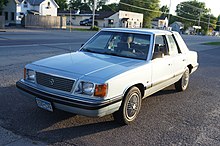
1988 Plymouth Reliant Exec Classic

1989-1990 Plymouth Acclaim

1989-1992 Plymouth Acclamation LX
Most Plymouth models, especially those offered from the 1970s onward, such equally the Valiant, Volaré, and the Acclamation, were badge-engineered versions of Dodge or Mitsubishi models.
The Plymouth Reliant and Dodge Aries were introduced for model yr 1981 as the first "K-cars" manufactured and marketed by the Chrysler Corporation. The Reliant was available as a 2-door coupe, 4-door sedan, or as a iv-door station carriage, in three different trim lines: base, Custom and SE ("Special Edition"). Station wagons came only in Custom or SE trim. Unlike many modest cars, the K-cars retained the traditional vi-passenger 2-bench seat with a column shifter seating arrangement favored by many Americans. The Reliant was powered past a then-new two.2 L I4 SOHC engine, with a Mitsubishi "Silent Shaft" 2.6 50 as an option (curiously this engine also featured hemispherical combustion chambers, and all 1981 models equipped with it featured "HEMI" badges on the front fenders). Initial sales were brisk, with both Reliant and Aries each selling over 150,000 units in 1981. Equally rebadged variants, the Reliant and Aries were manufactured in Newark, Delaware, Detroit, Michigan, and Toluca, Mexico — in a single generation. After their introduction, the Reliant and Aries were marketed equally the "Reliant K" and "Aries Thousand".[22]
The Reliant replaced the Plymouth Volaré/Road Runner. The Aries replaced the Dodge Aspen. The Reliant and Aries were classified past the EPA as mid-size and were the smallest cars to have six-rider seating with a 3-seat per row setup, like to larger rear-wheel bulldoze cars such as the Dodge Dart and other front end-wheel bulldoze cars such as the Chevrolet Celebrity. Chrysler marketed the car equally beingness able to seat "six Americans." The Aries was sold as the Dart in Mexico. The Reliant and Aries were selected together as Motor Trend magazine's Machine of the Year for 1981 and sold virtually a meg Aries and 1.i million Reliant units over the nine-year run.
In 1982, Plymouth downsized the Gran Fury again, this time sharing the mid-size One thousand platform with the Chrysler Fifth Avenue (called Chrysler New Yorker/New Yorker Fifth Artery for 1982 and 1983) and the Dodge Diplomat. In addition to the R-body Gran Fury, the G-trunk Gran Fury replaced the M-body Chrysler LeBaron, which had moved to the compact K platform that year. Now considered a mid-sized car, this generation Gran Fury was shut to the exterior size of what was once the compact Valiant and Volaré merely offered more interior room. The M-torso was in fact heavily based on the Volaré'southward F platform. Similar its predecessor, the 1982 Gran Fury was introduced subsequently than its Chrysler and Dodge siblings; the Chrysler LeBaron and Dodge Diplomat had used the M-body since 1977. 1982-1989 Plymouth Gran Furys shared the Contrivance Diplomat's front and rear fascias. They were virtually identical with the exception of badging. Over again, the third generation Gran Fury was bachelor in base of operations and higher-end "Salon" trim. As in previous years, the higher-volume Gran Fury base of operations model catered more towards fleet customers while Gran Fury Salons were geared more towards private customers and offered options such every bit full vinyl roofs, velour upholstery, turbine-spoke wheels, ability windows, and power locks. Although available to private retail customers, the One thousand-trunk Gran Fury was far more than popular with police departments and other armada customers, primarily since the automobile was reasonably priced and had a conventional drivetrain with proven components that could withstand a practiced bargain of abuse. This generation of the Gran Fury sold in respectable numbers. However, despite having the same base prices as the Gran Fury (just nether $12,000 USD for their final twelvemonth), the Diplomat e'er outsold it, usually by several thousand units each year. The Chrysler Fifth Avenue'south total sales were e'er more than that of the Gran Fury and Diplomat past far, even though information technology generally toll nigh $6,000 more than. This was the last car to carry the Gran Fury nameplate, only it remained largely unchanged for its seven-year run. Declining sales, a lack of promotion, and technical obsolescence—the platform dated dorsum to the 1976 Plymouth Volare and Dodge Aspen—eventually contributed to the model'south demise in early 1989. That year, a commuter-side airbag became standard; this would be the last RWD Plymouth until the introduction of the Prowler. While Contrivance offered the 1990 Monaco, and later the 1993 Intrepid, Chrysler never replaced the Gran Fury with any other large car in the rest of Plymouth's lineup on through to its demise in the 2001 model year.
In 1984, Chrysler marketed the rebadged Plymouth variant of its new minivan as the Voyager, using the Chrysler's S platform, derived from the K-platform (Plymouth Reliant and Dodge Aries). The Voyager shared components with the G-cars including portions of the interior, e.g., the Reliant's musical instrument cluster and dashboard controls, along with the 1000-platform front-wheel drive layout and low flooring, giving the Voyager a car-similar ease of entry. The Voyager was on Car and Commuter magazine's X Best listing for 1985.[23]
For 1987, the Voyager received small cosmetic updates as well as the May 1987 introduction of the 1000 Voyager, which was congenital on a longer wheelbase calculation more cargo room. It was available but with SE or LE trim. Showtime-generation Voyager minivans were offered in three trim levels: an unnamed base model, mid-grade SE, and loftier-stop LE, the latter bearing simulated woodgrain paneling. A sportier LX model was added in 1989, sharing much of its components with the Caravan ES. Condom features included 3-point seat belts for the front two passengers and lap belts for rear passengers. Standard on all Voyagers were legally mandated side-touch reinforcements for all seating front and rear outboard positions, but airbags or ABS were non available.[23] Notably, the Voyager, forth with the Dodge Caravan, are considered to exist the offset mass-produced vehicles to have dedicated built-in cup holders.[24] [25] Original commercials for the 1984 Voyager featured magician Doug Henning[26] as a spokesperson to promote the Voyager "Magic Railroad vehicle'south" versatility, cargo infinite, low pace-in pinnacle, passenger volume, and maneuverability. After commercials in 1989 featured rock singer Tina Turner.[27] Canadian commercials in 1990 featured pop singer Celine Dion.[28]
For 1987, which was the Sundance's start twelvemonth, it was available in a single base of operations model. For 1988, a higher-end RS model was bachelor. The RS model, which stood for Rally Sport, came with standard features that included two-tone paint, fog lights, and a leather-wrapped steering cycle. It was also available with a turbocharged 2.ii L I4 engine, and other amenities like an Infinity sound system, tinted window glass, and dual power mirrors. For 1991, the base of operations model divide into 2 distinct models: entry-level America and mid-level Highline, in add-on to the loftier-end RS. The stripped-down America had previously been offered for the Plymouth Horizon'southward final year in 1990.
The AA-body cars were badge-engineered triplets, as were most Chrysler products of this fourth dimension. The Acclaim differed from its siblings primarily in cycle choices, bodyside molding, and fascias where it sported its unique taillights and the corporate Plymouth eggcrate-grille. Like the K-body and E-body vehicles they replaced, the Acclamation and Dodge Spirit were both marketed as mainstream variants, while the Chrysler LeBaron was marketed equally the luxury variant. Despite this, there was substantial overlap in trims and equipment among each car. For example, a fully loaded Acclamation was almost similar to a base LeBaron in features and toll.[29]
In add-on to its entry-level base model, the Acclaim was initially available in mid-range LE and high-end Sixty trim. LE and Threescore models came equipped with features such including premium cloth seating, power windows/door locks, premium sound systems, bodyside cladding, additional exterior brightwork, and on the latter 15-inch lace-spoke aluminum wheels.[30] In spite of this, the base model accounted for nigh 85 percentage of Acclaim sales.[31] Unlike the Spirit, the Acclaim did non receive whatsoever sport-oriented models.[32] The Acclaim has as well been characterized as the replacement for the smaller Reliant,[33] [34] [35] though the Sundance launched in 1987 is closer than the Acclaim in near dimensions to the Reliant.
Final years: 1990s–2001 [edit]

Past the 1990s, Plymouth had lost much of its identity, as its models continued to overlap in features and prices with its sister brands, Dodge and Eagle.[31] Chrysler attempted to remedy this past repositioning Plymouth to its traditional target marketplace as the automaker'due south entry-level brand. This included giving Plymouth its ain new sailboat logo and advertisements that focused solely on value.[31] [36] Withal, this only further narrowed Plymouth'south product offerings and buyer appeal, and sales continued to fall.[37]
Chrysler considered giving Plymouth a variant of the highly successful new-for-1993 total-size LH platform,[38] which would take been called the Accolade, only decided against it. By the belatedly 1990s, only four vehicles were sold under the Plymouth name: the Voyager/K Voyager minivans, the Cakewalk mid-size sedan, the Neon compact machine, and the Prowler sports auto, which was to be the concluding model unique to Plymouth, though the Chrysler PT Cruiser was conceived as a concept unique to Plymouth before production commenced every bit a Chrysler model.

Late 1990s letter of the alphabet emblem from a 1999 Neon
After discontinuing the Eagle brand in 1998, Chrysler was planning to expand the Plymouth line with a number of unique models before the corporation's merger with Daimler-Benz AG. The first model was the Plymouth Prowler, a hot rod-styled sports car. The PT Cruiser was to have been the second. Both models had similar front-end styling, suggesting Chrysler intended a retro styling theme for the Plymouth brand. At the time of Daimler's takeover of Chrysler, Plymouth had no models besides the Prowler not also offered in a like version by Dodge.[ citation needed ]
From a peak production of 973,000 for the 1973 model year, Plymouth rarely exceeded 200,000 cars per year after 1990. Fifty-fifty the Voyager sales were commonly less than 50% that of Dodge Caravan. In Canada, the Plymouth name was defunct at the end of the 1999 model year. Consequently, DaimlerChrysler decided to drop the brand later on a express run of 2001 models. This was announced on November 3, 1999.[ citation needed ]
The last new model sold under the Plymouth marque was the second-generation Neon for 2000. The PT Cruiser was ultimately launched equally a Chrysler, and the Prowler and Voyager were absorbed into that brand, as well. Following the 2001 model year, the Neon was sold only as a Dodge in the US, though it remained available as a Chrysler in Canadian and other markets. The Plymouth Cakewalk was dropped after 2000, before Chrysler introduced their redesigned 2001 Dodge Stratus and Chrysler Sebring sedan.
Timeline [edit]

A 1949 Plymouth Special Palatial Station Wagon, advertisement
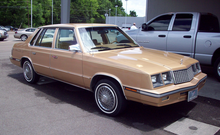
1984-1985 Plymouth Caravelle

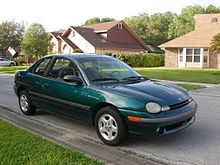

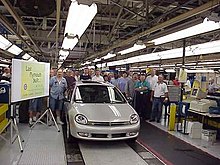
The Last Plymouth built, 2001
- 1955: Plymouth kickoff offered a V8 engine. Plymouth and the other Chrysler divisions received "The New 100-Million Dollar Look".
- 1956: The automatic iii-speed TorqueFlite manual was introduced on some premium models. The Plymouth Fury was introduced.
- 1957: As with all other Chrysler divisions, the Forward Look design made its debut on the 1957 Plymouths. Torsion-Aire front suspension was introduced on all models.
- 1960: Contrivance introduced the smaller, lower-priced Dart model that competed direct with Plymouth'south offerings. The new compact Valiant was introduced as a marque unto itself. All Plymouths now featured unit-torso construction. A new base of operations half-dozen-cylinder engine was introduced with a 30-degree camber and overhead valves.
- 1961: Valiant was repositioned every bit a Plymouth model for the US market place; Dodge got the badge-engineered Lancer version. Rambler and so Pontiac causeless third place in industry sales for the rest of the 1960s.
- 1962: Sales dropped dramatically with the introduction of a line of unpopularly styled, downsized total-sized models.
- 1963: Valiant received a new, trim torso resulting in a significant increase in sales. Full-sized models were restyled to look larger.
- 1964: The new Barracuda fastback coupe was introduced in Apr. Total-sized models were restyled with a new "slantback" hardtop coupe roofline.
- 1965: Plymouth rejoined the full-sized car market with the new Fury, based on the Chrysler C-body. The intermediate B-body model line became the Belvedere and Satellite for 1965. Push-push button automatic transmission controls were replaced with a conventional column- or flooring-mounted lever.
- 1967: The GTX was introduced.
- 1968: The Route Runner entered the Plymouth line-upward.
- 1970: Duster coupe was introduced in the Valiant line for 1970 as well as the new E-torso Barracuda.
- 1971: The British Hillman Avenger was imported equally the Plymouth Cricket; it was discontinued in mid-1973. The new Valiant Scamp ii-door hardtop was a badge-engineered Dodge Sprint Swinger.
- 1973: Plymouth production hit an all-time peak of 973,000. The Plymouth Cricket in Canada was now based on the Contrivance Filly.
- 1974: The full-sized Plymouth Voyager van, based on the like Dodge B-series van, and Trail Duster SUV, based on the Dodge Ramcharger, were introduced. The Dodge Dart and Plymouth Valiant were, for the first time, unlike only in name and pocket-sized trim details (grille and tail lamps) as the two cars at present shared the same 111-inch wheelbase (both divisions' fastbacks remain 108 in). The Barracuda was discontinued x years to the day information technology began production on April one.
- 1975: The car that was to become the 1975 Plymouth Sebring was instead released as the new Chrysler Cordoba.[ citation needed ]
- 1976: The Volaré was launched, and the Valiant was discontinued at year-end.
- 1977: The large Gran Fury was discontinued.
- 1978: The mid-sized Fury was discontinued at the end of the model year. The subcompact Horizon was introduced. Chrysler Canada introduced the Plymouth Caravelle based on the Contrivance Diplomat.
- 1979–1980: Chrysler made several k more Dodges than Plymouths for the first fourth dimension (404,266 to 372,449 in 1979 and 308,638 to 290,974 in 1980). More Plymouths would be made than Dodges for 1981 and 1982, only from then on, there would always be more than Dodges were made than Plymouths.
- 1980: The Newport-based Gran Fury (R-trunk) was introduced. This was the concluding twelvemonth for the Volaré and Road Runner.
- 1981: The Plymouth Reliant 1000 was introduced. The full-sized Gran Fury sedan and Trail Duster SUV were discontinued.
- 1982: The mid-sized Plymouth Gran Fury, a Dodge Diplomat with a Plymouth grille, was introduced in the United States.
- 1983: The subcompact Plymouth Scamp pickup, based on the Dodge Rampage, was introduced and sold for one year only. The Caravelle four-door sedan based on the E-body and a ii-door coupe based on the 1000-trunk were introduced in Canada. The sporty subcompact Horizon TC3 was renamed Turismo. The total-sized Voyager van was discontinued.
- 1984: The Voyager minivan and Mitsubishi-based Colt Vista multi-purpose vehicle (MPV) were introduced.
- 1985: The E-body Plymouth Caravelle was introduced in the United States.
- 1987: The compact P-torso Plymouth Sundance entered the line-upward with three- and v-door hatchbacks. The Turismo was discontinued, the five-door Horizon was rebranded "Horizon America" with the nigh popular options made standard equipment with the less-popular ones dropped, forth with a substantial price cut.
- 1987.v: The G Voyager, an extended wheelbase version of the preexisting Voyager, is introduced.
- 1989: The mid-sized Gran Fury (Caravelle in Canada), too equally the Reliant, were discontinued after this model twelvemonth. The Reliant and E-body Caravelle are replaced by the Acclaim.
- 1990: The Mitsubishi-based Plymouth Laser sport-compact was introduced. The L-body Horizon was discontinued.
- 1991: The second generation of the Voyager/Grand Voyager is introduced.
- 1992: The higher-priced Acclaim models were repositioned as entry trim Chrysler LeBarons. Total sales of Acclaim and LeBaron dropped. Total 1993 Plymouth model-twelvemonth product dropped to 159,775, along with 237,875 Voyager models. Dodge built 300,666 Caravans alone, and 263,539 non-Caravan models.
- 1994: The little-advertised Laser and the popular Sundance and Colt compacts all end production. They are replaced by a single car, the Neon, a car that Chrysler decided to offer equally a Plymouth after dealers protested the loss of the Sundance and Colt with no replacement.
- 1995: Plymouth'south lineup was at its all-fourth dimension depression, but iii cars: the Acclamation, the Neon, and the Voyager/Grand Voyager. The number went up to four in 1997, with the introduction of the Prowler, just never got any college.
- 1996: Chrysler announced the new Plymouth Breeze 6 months after sister Dodge Stratus and Chrysler Cirrus models. Chrysler originally had no plans to supercede the Acclamation model.[ commendation needed ] In an attempt to move Plymouth downmarket, Chrysler fabricated the redesigned Voyager simply available in base and mid-level SE models. All of the higher-finish trim levels available on the previous generation were now only be constitute on the Dodge Caravan. The high-end trim levels could still be institute in certain markets outside the US.
- 1997: Production for the 1997 model year was 178,807 cars plus 187,347 Voyager models. Dodge built 448,394 cars and 355,400 Caravans.
- 1999: Total 1999 production for Plymouth cars was to 195,714 with Dodge at 394,052. Voyager production numbered 197,020, compared to 354,641 Caravans. The redesigned 2000 Neon became the brand's concluding new model.
- 2000: The mid-sized Breeze ended production. This was also the terminal year for the Voyager minivan as a Plymouth. All 2000 Voyagers congenital in December 1999 and across were badged as Chrysler Voyagers. In Canada, the redesigned Neon was sold under the Chrysler proper name and both the Plymouth and Contrivance names were dropped on all car models, relieve for the Prowler and Viper. The Voyager name was dropped in Canada as all Chrysler dealers sold Dodge trucks, including the Caravan. Total 2000 model year production for Plymouth was 108,546 compared to 459,988 Dodge cars. Voyager production totaled 123,869 versus 330,370 Caravan models.
- 2001: In Plymouth's final model year, only the Neon remained. The Prowler and the Voyager became Chryslers. The Voyager gained a high-end LX trim, as well as a base eC trim, and it retained the SE trim. The Cakewalk was dropped as Chrysler issued the Chrysler Sebring sedan to supplant the Chrysler Cirrus. The PT Cruiser was launched equally a Chrysler, though it was originally planned to be a Plymouth. The concluding Plymouth, a Neon, was assembled on June 28, 2001 at Belvidere Assembly Establish, with a total of 38,657 congenital for the model year.
Plymouth car models [edit]
Plymouth models included:
- Plymouth Model 30U (1930)
- Plymouth Acclaim (1989–1995)
- Plymouth Arrow (1976–1980, rebadged Mitsubishi Lancer Celeste)
- Plymouth Arrow Truck (1979–1982, rebadged Mitsubishi Forte)
- Plymouth Barracuda (1964–1974)
- Plymouth Dais (1954–1970)
- Plymouth Breeze (1996–2000)
- Plymouth Business (1935–1938)
- Plymouth Caravelle (1985–1988)
- Plymouth Cambridge (1951–1953)
- Plymouth Champ (1979–1982, rebadged Mitsubishi Delusion)
- Plymouth Filly (1983–1994, rebadged Mitsubishi Mirage)
- Plymouth Colt Vista (1984–1994, rebadged Mitsubishi Chariot)
- Plymouth Commercial Car (1937–1941)
- Plymouth Hold (1951–1952)
- Plymouth Conquest (1984–1986, rebadged Mitsubishi Starion)
- Plymouth Cranbrook (1951–1953)
- Plymouth Cricket (1971–1975, rebadged Hillman Avenger)
- Plymouth Deluxe (1933–1942, 1946–1950)
- Plymouth Special Deluxe (1941–1942, 1946–1950)
- Plymouth Squeegee (1970–1976)
- Plymouth Fury (1956–1978)
- Plymouth Sport Fury (1959, 1962–1971)
- Plymouth VIP (1966–1969)
- Plymouth Gran Fury (1975–1977, 1980–1989)
- Plymouth Grand Voyager (1987–2000)
- Plymouth GTX (1967–1971)
- Plymouth Horizon (1978–1990)
- Plymouth Laser (1990–1994, rebadged Mitsubishi Eclipse)
- Plymouth Model PA (1931)
- Plymouth Model Q (1928)
- Plymouth Model U (1929)
- Plymouth Neon (1994–2001)
- Plymouth Plaza (1954–1958)
- Plymouth Prowler (1997 and 1999–2001)
- Plymouth Reliant (1981–1989)
- Plymouth Roadking (1938–1941)
- Plymouth Route Runner (1968–1975)
- Plymouth Sapporo (1978–1983, rebadged Mitsubishi Galant Lambda)
- Plymouth Satellite (1966–1974)
- Plymouth Savoy (1951–1964)
- Plymouth Scamp (1983)
- Plymouth Vi (1934)
- Plymouth Special Six (1934)
- Plymouth Standard (1933, 1935)
- Plymouth Sundance (1987–1994)
- Plymouth Suburban (1949–1961)
- Plymouth Superbird (1970)
- Plymouth TC3 (1979–1982)
- Plymouth Trail Duster (1974–1981)
- Plymouth Turismo (1983–1987)
- Plymouth Valiant (1960–1976)
- Plymouth Scamp (1971-1976)
- Plymouth Volaré (1976–1980)
- Plymouth Road Runner (1976–1980)
- Plymouth Voyager (1974–2000)
Plymouth trucks [edit]
Plymouth congenital diverse trucks and vans over the years, mainly rebadged Dodge or Chrysler vehicles. Early pickups, commitment trucks, and other commercial trucks were available, and later an SUV, full-sized vans, and minivans. Plymouth had supplied components to the Fargo vehicles, another fellow member of the Chrysler family unit, but entered the commercial market in 1937 with the PT50.[39]
-

1937 Express pickup
-

1937 PT50 commitment truck
-

1979 Trail Duster
-

1985 Voyager LE
-

1991 Thousand Voyager LE
-

1998 Voyager Expresso
Truck models [edit]
- Plymouth PT50 - 1937 - Express pickup, console delivery van, cab and chassis, station wagon
- Plymouth PT57 - 1938 - Limited pickup, console commitment van, cab and chassis
- Plymouth PT81 - 1939 - Express pickup, cab and chassis
- Plymouth PT105 - 1940 - Express pickup
- Plymouth PT125 - 1941 - Express pickup
- Plymouth Trail Duster - 1974-1981 - SUV, same as Dodge Ramcharger
- Plymouth Voyager (van) - 1974-1983 - total-sized van, same equally Contrivance Sportsman
- Plymouth Scamp - 1983 - forepart-wheel-drive pickup, same as Dodge Binge
- Plymouth Voyager (minivan) - 1984-2000 - minivan, same as Dodge Caravan and Chrysler Town & Country; also sold every bit Chrysler Voyager from 1999 to 2003
- Plymouth Arrow Truck - 1979-1982 - compact pickup built by Mitsubishi
Plymouth concept cars [edit]



1973 Plymouth (Rapid Transit Arrangement) Duster 340
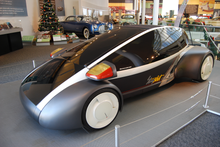
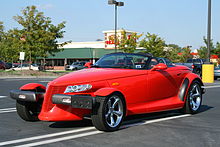
| Model | Year | Type | Specifications | Features |
|---|---|---|---|---|
| XX-500[40] | 1951 | Sedan | ||
| Belmont | c. 1953 | ii-seater Convertible | three.9 L 150 hp (112 kW; 152 PS) V8 | |
| Explorer | 1954 | Coupé | 3.seven 50 110 hp (82 kW; 112 PS) Straight-6 engine | |
| Cabana | 1958 | Station wagon | Non-runner | Unique glass roof for the rear portion of the car. |
| XNR | 1960 | two-seater convertible | 2.8 L 250 hp (186 kW; 253 PS) Straight-half-dozen engine[41] | |
| Asimmetrica | 1961 | 3.7 L 145 hp (108 kW; 147 PS) Direct-6 engine[42] | ||
| Valiant St. Regis | 1962 | Coupé | ||
| Five.I.P. | 1965 | iv-seater convertible | Unique roof bar from the meridian of the windshield to the rear deck. | |
| Barracuda Formula SX | 1966 | Coupé | ||
| Duster I Road Runner | 1969 | 340 hp (254 kW; 345 PS) V8 426 hp (318 kW; 432 PS) V8 | All features of the Route Runner plus flaps on superlative and sides and adjustable spoilers on the side of the rear fender, all to reduce lift. | |
| Rapid Transit Arrangement 'Cuda (440) | 1970 | Convertible | ||
| Rapid Transit System Road Runner | Coupé | Three-colored tail lights: cherry-red for "braking", yellow for "coasting" and green for "on the gas". | ||
| Rapid Transit Organization Duster 340 | 5.6 L c. 300 hp (224 kW; 304 PS) V8[43] | |||
| Concept Voyager II | 1986 | Minivan | ||
| Slingshot | 1988 | ii-seater coupé | 2.two L 225 hp (168 kW; 228 PS) turbocharged Straight-four engine | Canopy that swings upward to open the car Adaptable 4-wheel independent interruption Keyless credit card-similar entry Combined headlight and rear-view mirror pods Exposed engine and suspension |
| Speedster | 1989 | two-seater convertible | No opening doors | |
| Voyager iii | Minivan | The front of the car could be driven by itself or driven when fastened to a "miniature tractor-trailer" Drinking glass roof | ||
| X2S | Coupé Convertible | 2.0 L (turbocharged) 167 hp (125 kW; 169 PS) V6 | ||
| Breeze | c. 1990 | Sedan | ii.0 L 132 hp (98 kW; 134 PS) 4 cylinder engine 2.4 50 150 hp (112 kW; 152 PS) Straight-four engine | |
| Prowler | 1997 | Convertible | 3.five L 214 hp (160 kW; 217 PS) V6 | |
| Expresso | 1994 | Compact car | ||
| Haversack | 1995 | two-seat truck | 2.0 L 135 hp (101 kW; 137 PS) Inline-4 engine | Space for a laptop on a small table Congenital-in cycle rack on the dorsum |
| Pronto | 1997 | Sedan | ane.6 L 115 hp (86 kW; 117 PS) Inline-four engine | The front of the car resembled that of the Prowler Roll-back material top |
| Pronto Spyder | 1998 | Convertible | two.four 50 225 hp (168 kW; 228 PS) Straight-iv engine | |
| Howler | 1999 | 3.5 50 c. 250 hp (186 kW; 253 PS) V6 four.7 L c. 250 hp (186 kW; 253 PS) V8 | ||
| Voyager XG[44] | Minivan | 2.5 L 115 hp (86 kW; 117 PS) turbocharged diesel engine | Powered retractable sunroof |
References [edit]
- ^ Curcio, Vincent (2000). Chrysler: The Life and Times of an Automotive Genius. Oxford University Press. p. 394. ISBN9780195078961 . Retrieved 17 March 2018.
- ^ Sloan, Alfred (2003). Wood, John C.; Woods, Michael C. (eds.). Alfred P. Sloan: Critical Evaluations in Business organization and Management. Vol. 1. Routledge. p. 234. ISBN9780415248297 . Retrieved 17 March 2018.
- ^ a b Hyde, Charles (2003). Riding the Rollercoaster: A History of the Chrysler Corporation. Wayne Country University Press. p. 76. ISBN9780814330913 . Retrieved 17 March 2018.
- ^ 1634–1699: McCusker, J. J. (1997). How Much Is That in Real Coin? A Historical Price Index for Employ as a Deflator of Money Values in the Economy of the United States: Addenda et Corrigenda (PDF). American Antiquarian Order. 1700–1799: McCusker, J. J. (1992). How Much Is That in Real Coin? A Historical Cost Index for Use equally a Deflator of Coin Values in the Economy of the United States (PDF). American Antiquarian Society. 1800–present: Federal Reserve Banking concern of Minneapolis. "Consumer Toll Index (gauge) 1800–". Retrieved January 1, 2020.
- ^ a b Kimes, Beverly Rae; Clark, Jr., Henry A. (1996). Standard Catalog of American Cars 1805–1942 (Third ed.). Krause Publications. p. 1198. ISBN978-0-87341-428-9 . Retrieved 17 March 2018.
- ^ Knutson, Lanny. "What'due south in a Proper noun? (How Plymouth Was Named)". Allpar.com. Retrieved 17 March 2018.
- ^ Kimes, Beverly Rae; Clark, Jr., Henry A. (1996). "Plymouth". Standard Itemize of American Cars 1805-1942 (Tertiary ed.). Krause Publications. pp. 1198–1215. ISBN9780873414289 . Retrieved 17 March 2018.
- ^ Curcio, Vincent (2000). Chrysler: The Life and Times of an Automotive Genius. Oxford University Press. p. 473. ISBN978-0-19-514705-6 . Retrieved 17 March 2018.
- ^ "Walter P. Chrysler Announces New Plymouth Floating Power .. and Complimentary Wheeling". The Gettysburg Times -- Pennsylvania (advertisement). half-dozen July 1931. p. 3. Retrieved 6 July 2018.
- ^ "1937 Plymouth "Biggest Value Brochure"". oldcarbrochures. p. 19. Retrieved 17 March 2018.
- ^ Sherlock, Joseph M. "1939 Plymouth – history". Joesherlock.com. Retrieved 17 March 2018.
- ^ Cobb, James (15 June 1997). "The Render of Detroit'south 'Low Priced Three'". The New York Times . Retrieved 17 March 2018.
- ^ a b Benjaminson, Jim. "Plymouth cars 1957: Iii Years Alee". Allpar.com. Retrieved 17 March 2018.
- ^ Redgap, Curtis. "Insider'due south history of Plymouth - Role 5". Allpar.com. Retrieved 17 March 2018.
- ^ "Turbo Plymouth Threatens Time to come of Standard". Pop Science. 165 (i): 102–103. July 1954. Retrieved 17 March 2018.
- ^ Mitchell, Larry Yard. (2000). AMC Muscle Cars. MBI Publishing. p. 55. ISBN9780760307618 . Retrieved 2015-03-30 .
- ^ Newhardt, David (2000). Dodge Challenger & Plymouth Barracuda. MotorBooks International. p. 42. ISBN9780760307724.
- ^ Newhardt, David (2000). Contrivance Challenger & Plymouth Barracuda. MotorBooks/MBI. p. 7. ISBN978-0-7603-0772-4 . Retrieved 2010-07-04 .
- ^ "1970 Salesman'due south Pocket Guides". hamtramck-historical.com. pp. l–51. Retrieved 18 Nov 2020.
- ^ "Dodge Challenger Specs - 1970 Challenger Deputy". challengerspecs.com . Retrieved 18 November 2020.
- ^ "1970 Barracuda production totals by powerteam". Plymouthbarracuda.net. Retrieved 2010-07-04 .
- ^ Gilded, Aaron; Swern, Michael. "Kronology: History of the 1000-Car (Plymouth Reliant, Dodge Aries, C. LeBaron)". Allpar Forums . Retrieved 18 November 2020.
- ^ a b "A Brief History of the Chrysler Minivan". Allpar.com . Retrieved 2008-06-13 .
- ^ Pages, The Club. "When Did Cars Go Cup Holders? - Sociological Images". Retrieved 2019-01-xiii .
- ^ Dean, Sam. "The History of the Car Cup Holder". Bon Appetit . Retrieved 2019-01-13 .
- ^ "1984 plymouth voyager commercial", retrieved on 2010–08–25.
- ^ "1989 Tina Turner Plymouth Voyager Commercial", retrieved on 2010–08–25.
- ^ "Celine Dion : 1990 Contrivance Caravan & Plymouth Voyager", retrieved on 2010–08–25.
- ^ "Plymouth Acclamation Prices" Archived 2012-03-15 at the Wayback Automobile, retrieved on 2011–01–17.
- ^ Chrysler Corporation Mill Sales Brochure "1990 Plymouth Acclaim"
- ^ a b c Auto editors of Consumer Guide (18 June 2007). "How Plymouth Works: 1990, 1991, 1992 Plymouths". HowStuffWorks. Retrieved 2011-01-17 .
- ^ "Plymouth Acclaim, Dodge Spirit, Chrysler LeBaron and Saratoga" Information courtesy of Chrysler, allpar, retrieved on 2011–01–17.
- ^ Fifty Years of American Automobiles, the editors of Consumer Guide, Beekman House 1989, p. 335
- ^ [Swern, Michael; Gold, Aaron (September 26, 2006). "K-Chronology - Plymouth Reliant and Contrivance Aries, year to year". Allpar. Retrieved June vi, 2007. ]
- ^ Consumer Guide Archived 2006-05-29 at the Wayback Machine
- ^ Yates, Brock (1996). "x. Showtime in St.Louis". The Disquisitional Path: Inventing an Automobile and Reinventing a Corporation. Little, Brown. pp. 209–211. ISBN9780316967082.
- ^ Motorcar editors of Consumer Guide (eighteen June 2007). "How Plymouth Works: 1997, 1998, 1999, 2000, 2001 Plymouths". HowStuffWorks. Retrieved 17 March 2018.
- ^ "Dodge Intrepid, Eagle Vision, Chrysler 300M, New Yorker, and LHS - the LH cars, with reviews". Allpar.com. Retrieved 17 March 2018.
- ^ Benjaminson, Jim. "Plymouth commercial vehicles". Allpar.com. Retrieved 2011-06-26 .
- ^ "1951 Plymouth Twenty-500". conceptcars.information technology. Archived from the original on 30 December 2010. Retrieved 17 March 2018.
- ^ "1960 Plymouth XNR - Monterey 2012 - RM Sotheby's".
- ^ "1962 Plymouth Ghia Asimmetrica specifications, information, data, photos 228668". www.carfolio.com.
- ^ "1970 Plymouth Duster 340". ten January 2007.
- ^ "Plymouth Voyager XG Concept Minivan Appeals to New Generation". www.theautochannel.com.
External links [edit]
- Official website (Archive, 13 Oct 1999)
- Plymouth cars on AllPar.com
- IMCDB: Plymouth vehicles in movies and Telly shows
- Shah of Iran'due south Plymouth XNR sells for $935,000
Source: https://en.wikipedia.org/wiki/Plymouth_(automobile)
Posted by: creekmoremustence.blogspot.com


0 Response to "Did Plymouth Put A 392 In Any Of Their Cars"
Post a Comment